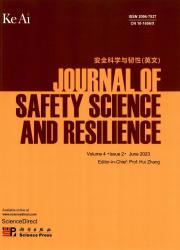基于“压力-状态-响应”的中国城市群地下空间安全弹性评价——以26个城市地下轨道交通为例
IF 3.4
Q1 PUBLIC, ENVIRONMENTAL & OCCUPATIONAL HEALTH
引用次数: 0
摘要
城市地下空间灾害具有因果机制复杂、危险性高的特点。它们还表现出不可预测性和风险耦合放大。城市群地下空间安全弹性差异及其关键路径是目前研究的热点问题。本研究基于弹性成因的视角,构建了压力-状态-反应(PSR)分析框架。本研究采用综合指数法、达格姆基尼系数法、模糊集定性比较分析法(fsQCA)等方法,探讨城市群地下空间安全弹性水平差异和关键通道差异。研究发现:(1)五大城市群安全弹性指数从高到低依次为成渝城市群、珠三角城市群、京津冀城市群、华中三角城市群和长三角城市群。并将城市地下空间安全弹性系统集群划分为示范引领型、奋发追赶型和稳定发展型。(2)城市群整体差异体现在单个城市群之间的差异上。内部发展不平衡是珠三角城市群与长三角城市群差异显著的主要原因。③城市地下空间的高安全弹性是PSR框架中多因素综合作用的结果。此外,还存在4种高水平安全弹性配置路径,这些路径可分为“状态驱动响应”、“压力触发响应”和“自主响应”三种模式。针对城市地下空间安全弹性的各种模式,提出了城市地下空间开发的政策启示和对策。这些建议为优化城市群地下空间安全弹性提供了理论参考。本文章由计算机程序翻译,如有差异,请以英文原文为准。
Evaluation of the underground space safety resilience of Chinese urban agglomerations based on the “Pressure-State-Response”: A case study of underground rail transit in 26 cities
Urban underground space disasters exhibit characteristics including complex causal mechanisms and high risk. They also present unpredictability and risk coupling amplification. Differences in underground space safety resilience (USSR) and key pathways of urban agglomerations are issues that remain under-discussed. This study is based on the perspective of resilience genesis, and it constructs a Pressure-State-Response (PSR) analysis framework. This study employs methods such as the composite index method, Dagum Gini coefficient, and fuzzy set Qualitative Comparative Analysis (fsQCA) to explore the differences in safety resilience levels and key pathways of underground spaces of urban agglomerations. The study offered several findings: (1) The safety resilience index rankings of the five major urban agglomerations, from highest to lowest, are as follows: Chengdu-Chongqing City Group, Pearl River Delta urban agglomeration, Beijing-Tianjin-Hebei urban agglomeration, Triangle of Central China and Yangtze River Delta urban agglomeration. In addition, the underground space safety resilience systems of cities were clustered and categorized into demonstration and leadership type, striving catch-up type, and stable development type. (2) Overall differences between urban agglomerations are reflected in the differences between individual urban agglomerations. The internal development imbalance is the primary reason for the more significant differences in and between the Pearl River Delta and Yangtze River Delta urban agglomerations. (3) High-level safety resilience of urban underground space is the result of a multi-factor combination in the PSR framework. In addition, there are four high-level safety resilience configuration paths, and these paths are categorized into three modes: "state-driven response", "pressure-triggered response", and "autonomous response". Policy implications and countermeasures for urban underground space development are proposed for each mode of urban underground space safety resilience. These proposals offer theoretical references for optimizing the safety resilience of underground spaces of urban agglomerations.
求助全文
通过发布文献求助,成功后即可免费获取论文全文。
去求助
来源期刊

安全科学与韧性(英文)
Management Science and Operations Research, Safety, Risk, Reliability and Quality, Safety Research
CiteScore
8.70
自引率
0.00%
发文量
0
审稿时长
72 days
 求助内容:
求助内容: 应助结果提醒方式:
应助结果提醒方式:


